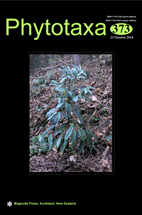Abstract
SAYA TAMURA, TOMOKO FUKUDA, ELENA A. PIMENOVA, EKATERINA A. PETRUNENKO, PAVEL V. KRESTOV, SVETLANA N. BONDARCHUK, OLGA A. CHERNYAGINA, YOSHIHISA SUYAMA, YOSHIHIRO TSUNAMOTO, AYUMU MATSUO, HAYATO TSUBOI, HIDEKI TAKAHASHI, KEN SATO, YOKO NISHIKAWA, TAKASHI SHIMAMURA, HIROKO FUJITA & KOH NAKAMURA An alpine plant Saxifraga yuparensis is endemic to a scree consisting of greenschist of Mt. Yubari in Hokkaido, Japan and it has been proposed as an immediate hybrid derived from two species of the same section Bronchiales based on morphological intermediacy: namely S. nishidae, a diploid species endemic to a nearby cliff composed of greenschist and tetraploid S. rebunshirensis comparatively broadly distributed in Japan and Russian Far East. Saxifraga yuparensis is red-listed and it is crucial for conservation planning to clarify whether this is an immediate hybrid and lacks a unique gene pool. The immediate-hybrid hypothesis was tested by molecular and cytological data. In nuclear ribosomal and chloroplast DNA trees based on maximum parsimony and Bayesian criteria, S. yuparensis and S. rebunshirensis formed a clade with several other congeners while S. nishidae formed another distinct clade. Genome-wide SNP data clearly separated these three species in principal coordinate space, placing S. yuparensis not in-between of S. rebunshirensis and S. nishidae. Chromosome observation indicated that S. yuparensis is tetraploid, not triploid directly derived from diploid-tetraploid crossing. Additionally, observation of herbarium specimens revealed that leaf apex shape of S. yuparensis fell within the variation of S. rebunshirensis. These results indicate that S. yuparensis is not an immediate hybrid of S. rebunshirensis and S. nishidae but a distinct lineage and an extremely narrow endemic species, that deserves for intensive conservation.

